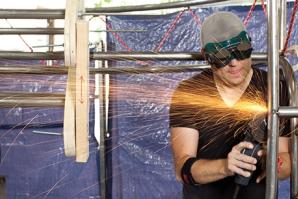Northern California’s economy hasn’t edged far enough into recovery to encourage strong hiring. The bouncing stock market, shaky European economies and an upcoming presidential election have many managers wondering what kind of business climate they’ll be dealing with a year from now.
So when companies require an extra hand, many of them turn first to temporary workers.
“There’s definitely, I wouldn’t say a fear, but a hesitation that a lot of companies have developed coming out of the recession,” says Joshua Leighton, assistant branch manager at AppleOne Inc., a job placement company in Sacramento.
About 140 new clients signed up with his office last year, making it the top branch for new business nationwide.
“This year we are going to be posting our best year in about 10 years. There has definitely been a good spike,” he says. Permanent and contract hires are part of that mix, but temporary workers are the bulk.
“I think it’s a normal trend,” says Pamela Randall, regional director for Manpower of Sacramento, another staffing agency. Coming out of a recession, some companies like temporary staff because they provide an interim step toward a permanent hire. Temping can serve as a kind of probationary period in which companies can see if an employee is a good fit while also making sure the budget is strong enough to sustain a permanent addition.
That’s a strategy some companies use even in good times. To smooth work flow, SureWest Communications, a regional telecomm provider, uses temps for its call center and installation jobs, says spokeswoman Anne Chacon. The temp work has a nine-month limit: Three months of training before workers go on the floor or in the field, then more training a month and a half later. At the end of the nine months, they get an offer or a farewell.
Training temps is no small matter. In spite of the high unemployment rate, the skills in the labor pool don’t always align with job openings. The list of hard-to-fill positions includes salespeople, nurses, technicians and other skilled trades, Randall says.
“Overall, I think that Sacramento has a good labor pool. I think the challenge is that companies need to look for transferable skills as opposed to direct job skills,” Randall says. Someone may not have experience in medical billing, for example, but may have done well at data entry. Someone may never have worked at a contact center but has held retail jobs involving lots of public contact.
“Most companies would prefer to have people come in with experience because it does lessen some of their costs. But almost all companies have some kind of an on-boarding process that touches on the company’s expectations and how the systems operate,” Randall says. Adding a little classroom training may be enough to close the gap.
With double-digit unemployment across the region, it might not seem logical that Sacramento would have so great a mismatch between people and jobs. But in one sense, it is a sign of recovery.
“A year, a year and a half ago, it would be a pretty simple process to find anybody at any level for a company out there,” Leighton says. Every level of the market was flooded with talent, from entry level to CEO. Now, the top tier of candidates has been hired, and it’s getting tougher to find strong contenders. That, in fact, is where the temp agencies work hardest to earn their fees: vetting candidates to send to client companies.
Like any problem of supply and demand, that means some employers will feel pressure to offer permanent jobs to applicants with hard-to-find skills, says Jay Jurschak, president of Pacific Staffing in Sacramento. They may have to offer a fatter paycheck, too.
“Most companies we have seen over the years really do not like to do periods of layoffs. It is very challenging, very difficult to do,” Jurschak says.
Any news that points to more hires or better pay is welcome after so many years of recession, even if it’s not as optimistic as some might have expected, he says.
“Normally at this point in the cycle, coming out of a recession, you would have generally seen the full-time, or what we used to call permanent placement, snap back more than it has,” Jurschak says. Some parts of California are already seeing it, especially in tech-heavy spots like Silicon Valley and Southern California.
He doesn’t see that happening in the Capital Region’s immediate future. Sacramento is getting a double whammy as governments rein in budgets, leaving less money flowing to local businesses.
“Our industry is a really good predictor of employment and where it is going. Usually you can see it six months before you see a perk-up in demand,” he says.
What the numbers do show is gradual improvement. Pacific Staffing’s survey of hiring trends for the first quarter of 2012 showed 58 percent of companies planning to hire, up from 51 percent a year earlier and 46 percent in the first quarter of 2010.
In polling 100 companies by phone in late November and early December, Pacific Staffing found only two companies planning layoffs in the first quarter, and one of those was for seasonal reasons.
Manpower takes a slightly different measure of the Sacramento market in its own survey, taking into account that some hiring is only to replace workers who have retired or otherwise left their jobs.
Manpower’s survey for January to March showed 18 percent of companies planning to hire more employees, while 8 percent expected to reduce staff. The bulk of surveyed companies — 68 percent — expected to maintain current workforce levels. The remaining 6 percent hadn’t figured out a course of action yet.
Recommended For You

Independents’ Day
Look out 9-to-5, the freelancers are coming
Casey Marshall is hunched over his phone, furiously scrolling through his Twitter feed in search of a photo of Waste Management’s promotional robot, whose broken axle he fixed back in March. “Someone came into the Hacker Lab and needed his robot repaired,” he says, grinning, “and I was like, ‘I gotta do that.’”

Think Anywhere
Is telecommuting the the wave of workforce future?
Pilot and Arba see those offices and the traditional 8-hour workday as inefficient and outdated relics of the industrial age, when a set shift and common location were vital for communicating and performing work.



